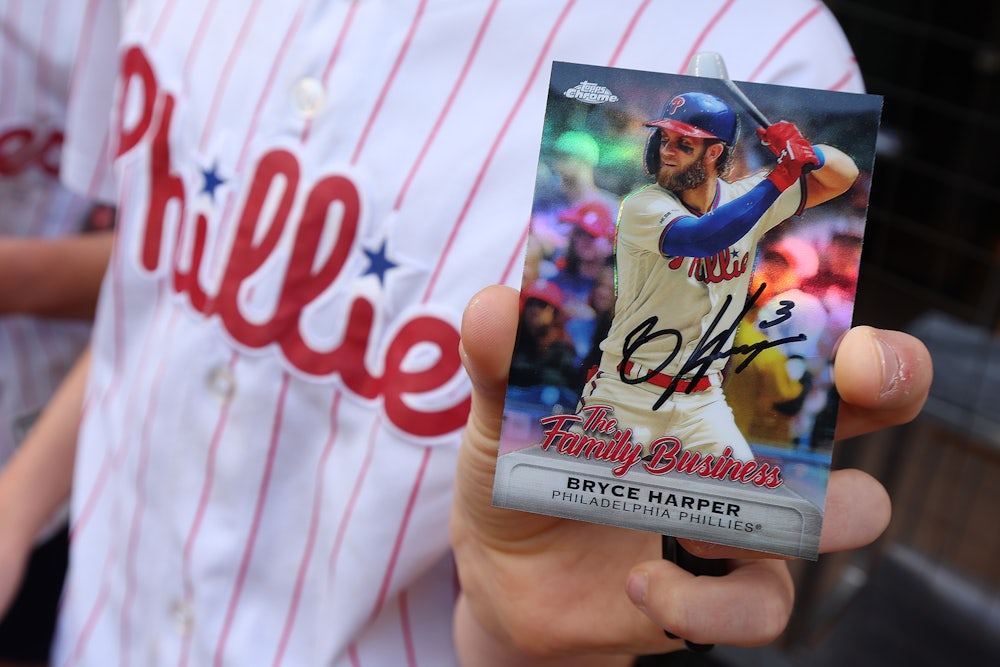It’s a boom time for antitrust laws. The Federal Trade Commission and the Justice Department are taking an aggressive new enforcement tack against companies for unfair practices and monopolization in the tech industry, the world of publishing, and more. Companies like Meta, Amazon, and Apple are all either fighting major regulatory lawsuits over their practices or bracing themselves for the inevitable.
But fights over industry consolidation aren’t limited to Silicon Valley or Wall Street. One of the most eye-popping examples came earlier this month when the two largest companies in the sports-card world traded lawsuits over the future of the multibillion-dollar industry. While it may not be the most important antitrust battle of the decade, it is a useful glimpse at how one company can rise to dominate an industry.
Panini, the Italian cardmaking company that currently holds the licenses for sports cards for three of the four major North American sports, filed a lawsuit last month against Fanatics, the American sports memorabilia company that is set to take over those licenses later this decade. Panini accused Fanatics of engaging in a variety of anticompetitive practices as it tries to consolidate its hold over the market; Fanatics responded a week later with its own lawsuit that claimed Panini resorted to unfair and deceptive business practices in retaliation for losing the licenses.
Panini’s woes escalated on Monday when the NFL Players Association told players’ agents that the union had “terminated” its licensing agreement with the company. “Effective immediately, Fanatics has the exclusive right to make NFLPA-branded trading cards,” the NFLPA said. With two weeks to go until the kickoff of the NFL season and multiple Panini products already in the production pipeline, it’s unclear whether Panini will be able to sell cards featuring this year’s rookie class of players, potentially costing the company millions of dollars in sales.
What’s at stake is no less than effective control over the future of sports cards, which are perhaps the most lucrative collectibles market in the country. Mint-condition rookie cards for players like Roger Maris, Tom Brady, and Michael Jordan have often sold for millions of dollars at auction. Beneath that uppermost crust, the hobby is also surging in popularity and value among ordinary collectors and sports fans—with more than 1,000 card shows planned across the country this year. Exact estimates of the industry’s size vary, but most are in the tens of billions of dollars.
In its 56-page complaint, Panini casts its adversary as the East India Company of the sports collectibles world. It claimed that Fanatics is trying to monopolize the American sports-card market by aggressively seeking multidecade licensing deals, acquiring any potential competitors, and resorting to strong-arm tactics to undermine any rivals who resist their takeover. “Without redress, consumers will suffer, prices will rise, quality will fall, and innovation will be stifled,” the company said in its lawsuit.
Like all conquerors, Fanatics frames itself as an innovative disruptor that overthrew an undesirable status quo. In its 101-page counter-lawsuit, it describes Panini as an antiquated foreign incumbent that rightfully lost its preeminent position after growing complacent and alienating its customer base. Panini, in Fanatics’ version of events, is hoping to mitigate its losses through trickery, deceit, and litigation.
“Panini’s strategy is an admission of its ineptitude: rather than elevating the collector experience, granting licensors access to downstream opportunities, or improving the broader industry, Panini is trying to undermine its competitor through unfair tactics so that it may continue to treat its American subsidiary as an ATM serving its private owners in Italy,” Fanatics argued in its lawsuit. “But Fanatics Collectibles will not be bullied.”
Antitrust issues are not new to the sports-card industry. In 1980, the Federal Trade Commission ruled that Topps had attained an unlawful monopoly after it signed more than 6,500 baseball players to exclusive agreements; the ruling briefly broke the company’s decades of dominance over the industry. That decision was later overturned by a federal appeals court, but two rival companies managed to enter the market in the interim and exploit loopholes in Topps’s exclusivity contracts. Upper Deck, an upstart company that pioneered higher quality cards, joined the fray in the early 1990s. While baseball cards have always led the way, football and basketball cards are now almost as popular.
In today’s market, licensing agreements are negotiated between the cardmakers, the league, and the players’ unions. The leagues control the license for each team’s marks, logos, and identifying colors, while the players’ unions generally control their likenesses. (Players can also negotiate these deals individually, as we’ll describe later.) It’s possible for a company to release sports cards without these licenses, but it has to airbrush out the players’ uniform and team logo and the cards won’t be printed with a player’s autograph already on them. As you can imagine, these cards are far less desirable among collectors.
Consolidation had already happened over the last two decades, especially after Panini acquired some of the major licenses. But Fanatics’ rise in the sports-card industry still reads like a tale of ruthless conquest. In the summer of 2021, the company suddenly announced a series of long-term licensing agreements with MLB, the NBA, the NFL, and their respective players’ unions after the current licenses expire in 2025 and 2026. This represented a major step toward consolidating the sports-card market. Fanatics capped off its acquisition spree and its metaphorical conquest a few months later by buying Topps, which held the MLB license for almost 70 years, and absorbing its operations.
“Panini was not given an opportunity to bid or otherwise compete for the licenses Fanatics acquired,” Panini said in its complaint. “Panini only learned about Fanatics’ exclusive agreements after they were consummated, through reading about them in the media. By combining long-term exclusive licenses for every major U.S. professional sports league and their respective players associations, Fanatics positioned itself to drive Panini and other potential competitors out of the market, and erected barriers to entry blocking their return.” The NBA license is for 10 years; the NFL and MLB ones are for at least 20.
Licenses aren’t the only challenge for would-be cardmakers. Every collectible industry has to balance scarcity with accessibility. If something is too hard to obtain, then the market will be too small for most potential collectors to participate in it. Everyone knows what a Fabergé egg, for example, is, but only a handful of people on the planet could ever own one. If something is too easily obtainable, on the other hand, then it loses any sense of aesthetic or intrinsic value. Sports-cards collectors are deeply familiar with the latter end of the spectrum: The late 1980s and early 1990s are known as the “junk wax” era because cards from that period were severely overprinted.
Modern sports cards try to avoid a repeat of that phenomenon in a few different ways. Collectors who open packs today can sometimes find rarer versions of the cards, which are pre-autographed by their favorite players. Certain card designs might only be available on a limited run where only a handful of them are ever printed, sometimes with fewer than 25 or 50 versions out there. Collectors can even find limited-run cards that have pieces of “authentic” game-worn jerseys built into them.
The most important tactic that card companies use nowadays is selling two versions of the same product. Modern sports cards are broken down into two categories: There are “retail” products that sell for lower prices at places like Target and Walmart, and then there are “hobby” products that sell for higher prices at local sports-memorabilia stores. Someone might be equally likely to find a Patrick Mahomes card or a Josh Allen card in each product, but the “hobby” versions will be higher quality, more exclusive, and thus theoretically more valuable in the long run.
Panini claimed that Fanatics had recently begun locking key individual players into exclusive autograph agreements, preventing those players from signing autographs on Panini’s cards even though it still retains the licenses to print them. That, in turn, would seriously undercut the value of future Panini products for the remainder of the license. Panini also claimed that Fanatics had cut off its supply of jerseys and other player-worn clothing that it incorporates into the higher-end cards, weakening it even further.
Fanatics did not seriously dispute those claims. It instead described at great length how Panini had failed collectors by releasing shoddy and borderline-fraudulent products, where cards that claimed to have “player-worn” or “game-worn” memorabilia incorporated into them had pieces of random jerseys instead. Fanatics pointed to instances where collectors on social media noted that an incorporated jersey couldn’t be authentic because it included part of a tag that showed it was made in the wrong year or because it had the wrong color scheme or team logo.
Those shortcomings, Fanatics claimed, have led to a loss of confidence both among customers and among license holders, which it says explains their defection to other cardmakers. They claimed that this poor reputation led the NHL and its players’ union to switch to Upper Deck in 2014 and reject Panini’s bid to reacquire the license in 2021. (The NHL is the last major North American league whose card licenses haven’t been acquired by Fanatics.) “In short, Panini has proven time and time again that its top priority is not collector experience or benefiting other industry stakeholders, but funneling profits back to Italy,” Fanatics argued in its lawsuit.
One of Panini’s most significant allegations is that Fanatics tried to undercut its place in the market before the licenses expire in a few years by acquiring control of GC Packaging, a longtime Panini partner that prints about 90 percent of its trading cards. GCP, according to Panini, is one of the few printing companies that can carry out the complex technical work of incorporating pieces of jerseys and genuine signatures onto its trading cards.
Panini claimed that the acquisition violated a provision in its contract with GCP that gave it the right to challenge a change in GCP’s ownership. The company also alleged that GCP began allocating fewer resources to Panini after the Fanatics purchase, undermining its production schedule in what Panini alleged was an attempt to force a sale of Panini’s North American operations to Fanatics, mirroring the latter’s takeover of Topps and other rivals.
The two companies do not dispute that there were negotiations about a sale, but they diverge wildly on what those failed talks looked like. Fanatics, for its part, claimed that it had negotiated with Panini since 2021 to buy out its North American operations but Panini had sought an “extortionate amount” from Fanatics in exchange for exiting the market early. Fanatics then went even further to claim that the Panini negotiations were carried out in bad faith while it sought to undermine Fanatics’ position in other ways.
“Desperate to sabotage Fanatics Collectibles’ progress, Panini first stooped to providing falsified earnings projections to bait Fanatics Collectibles into continuing sham talks of terminating Panini’s licenses, impeding Fanatics Collectibles’ business plans to work with players’ associations and individual athletes to grow the sports and entertainment collectible cards category,” the company claimed. “When that failed to work, Panini switched tactics and began a campaign of harassment in the courts.”
The two parties also disagree sharply about why a series of ex-Panini employees jumped ship for Fanatics after the licensing change in 2021. Panini alleged Fanatics representatives told dozens of Panini’s most important employees that they would never work in the sports-card industry again if they did not join Fanatics before the license went into effect, thereby hampering Panini’s ability to produce cards. In Fanatics’ version of events, Panini’s at-will employees left voluntarily to escape a declining company and were met with lawsuits and pressure campaigns by their former employer for their trouble, even though there were no noncompete clauses in their Panini contracts.
Beyond that, Panini also alleges a variety of other anticompetitive tactics, including spreading negative rumors about its business health, pressuring distributors and local card shops into cutting ties with it before the license expires, and so on. All of these practices, Panini says, have been deployed so that Fanatics can obtain a near-total lock on sports cards featuring American athletes, then use its position in the market to raise insurmountable barriers to any future competitors. That “monopolistic outcome,” it claims, would “[allow] Fanatics complete control to set and raise prices” and “reduce incentives for development of higher-quality cards and reduce consumer choice.”
Fanatics, for obvious reasons, does not see itself as a Gilded Age robber baron. But it doesn’t really try to refute the overall picture Panini paints of where things are headed. It instead claims that Panini is frustrated that it hasn’t capitalized on the latest changes within the sports-card industry before Fanatics. “Coinciding with Panini America’s decline, Fanatics has been revolutionizing the sports and entertainment collectibles business with a fresh model and vision that values and prioritizes the industry’s key stakeholders—athletes, players’ associations, collectors, leagues, and teams—rather than simply focusing on its own profits,” it claimed.
Not all of Fanatics’ planned innovations are necessarily friendly to collectors or customers in general, however. One of its planned changes is to more closely inject itself into the secondary market—the network of brick-and-mortar hobby stores and online marketplaces that allow collectors to easily buy and sell cards. For sports-cards and other similar trading-card communities, a producer like Panini only makes money when the cards are sold to the initial customer. Fanatics claimed in its lawsuit that its rival should have been trying to make money on subsequent trades and purchases as well.
“Unfortunately, this approach limits the financial benefit to licensors and prevents them from fully capitalizing on the value of their licensed intellectual property,” Fanatics claimed in its countersuit. “It also leaves Panini with less control over its products, depriving it and its licensors of the opportunity to engage with consumers downstream as much of the sports card community participates through hobby shops and secondary markets.” While Fanatics is vague on what the alternative would be, it sounds eerily like rent-seeking.
Another proposed innovation on Fanatics’ part is to engage directly with what are known as “box breakers,” a popular and controversial new trend in the sports-card world. A “breaker” typically buys large amounts of unopened card packs and boxes and then opens them live on YouTube, Twitch, or TikTok. Before the packs and boxes are opened, collectors can buy a portion of whatever comes out of them. The breaker then ships those cards directly to whoever wins them.
Imagine, for instance, that a breaker obtains a box of baseball cards that costs him $3,000. (Yes, some of the boxes cost that much.) A fan of the Los Angeles Angels could then pay $300 to buy whatever cards of Angels players are in it. The breaker then opens the box on a livestream and shows whatever cards are in it. There is noise and celebration and music whenever a high-value card is pulled. The most skilled breakers draw out the experience by unveiling each card slowly, letting the anticipation build gradually. There is an inescapable sense of community and camaraderie among those who participate.
The business model is obviously great for breakers: They make an easy profit as long as the total payments from each participant exceeds the amount they paid for the box, and the risk of opening cards that are worth less than they paid for the box is off-loaded onto someone else. Breaking can also be pretty good for a participant if they are lucky enough. The aforementioned Angels fan would save a ton of money if the break includes a rare or valuable Shohei Ohtani card, which can be valued at thousands or tens of thousands of dollars on the secondary market. They might even make money if they choose to resell it.
But box breaking is also uncomfortably similar to gambling. Most of a break’s participants will not break even—if they did, then the breaker would be better off opening the box themselves—and the livestreams often rely on a fear of missing out to lure in new customers. Panini has generally refused to sell products directly to breakers or incorporate them into its business model.
Fanatics, on the other hand, wants to make them a core feature of its new approach. “The emergence of breaking represents a remarkable shift in the way consumers engage with trading cards, transforming it into a shared, community experience,” the company claimed in its lawsuit. “It offers another layer of excitement to the hobby, akin to the thrill of opening a pack of cards, but amplified by the sense of anticipation shared with others.”
If Panini prevails in its lawsuit, Fanatics will have to disgorge itself of GCP and cease its alleged anticompetitive conduct. That will slow but not stop the firm from dominating the sports-card industry. (If Fanatics prevails on its claims, Panini will mainly have to pay it a lot of money.) And while sports cards are just a hobby, they may also become a textbook example of how one company can come to dominate an entire market—and then use that dominance to do whatever it wants to those who’ve invested so much time and effort into it. It would be a quintessentially American fate for a quintessentially American pastime.










